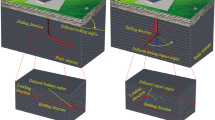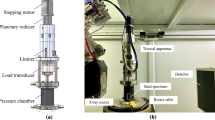Abstract
The hard rock roof in coal mines is prone to failure, causing catastrophic disasters due to highly concentrated stresses. Acidification can effectively degrade the resulting mechanical properties of hard rocks. Therefore, quantitative assessment and understanding of the tensile properties and microscopic characteristics of acidified limestone is essential for rock engineering. In this work, Brazilian splitting tests (BSTs) were carried out on acid-immersed limestone specimens and the resulting properties were determined by digital image correlation (DIC), 3D scanning, and nanoindentation. The effects of varying pH values on tensile properties, splitting surface morphology, and nanoindentation characteristics were investigated. The results indicate the tensile strength decreases with the decrease in pH value, while the splitting failure mode gradually transitions from I-shaped tensile to Y-shaped tensile-shear failure mode. Further, DIC results indicate that the maximum principal strain increases gradually. The evaluation of the splitting surface also showed that the roughness, relative fluctuation height, angle, area ratio of the splitting surface, and the range of indentation depth increase as the pH value decreases, while the relative fluctuation height increases the most. Nanoindentation confirms that the micromechanical parameters (hardness, modulus, and fracture toughness) degrade to varying degrees due to the acidification. Finally, the correlation between tensile strength and micromechanical parameters was developed for a better understanding of the microscopic deterioration mechanism in acidified limestone.
Highlights
-
Acidification significantly affects the tensile strength and failure mode of limestone specimens.
-
Micromechanical properties are gradually decreased as pH decreases.
-
Tensile strength and micromechanical parameters are correlated.
-
Acidification modifies the pore structure and micromechanical properties, reducing tensile strength.

























Similar content being viewed by others
Data availability
The data that support the findings of this study can be available from the corresponding author upon reasonable request.
References
Ayyaz M, Taqi A, Murtada S, Theis S, Jack D (2022) Impact of acid wormhole on the mechanical properties of chalk, limestone, and dolomite: experimental and modeling studies. Energy Rep 8:605–616
Chen C, Peng S, Wu S, Xu J (2019) The effect of chemical erosion on mechanical properties and fracture of sandstone under shear loading: an experimental study. Sci Rep 9:19886
Chen X, Liu X, Luo H, Long L, Liu C (2022) Microscopic damage to limestone under acidic conditions: phenomena and mechanisms. Sustainability 14(18):11771
Cui H, Tang J, Jiang X (2020) Effects of different conditions of water cooling at high temperature on the tensile strength and split surface roughness characteristics of hot dry rock. Adv Civ Eng 2020:8868140
Dong X, Wu Y, Cao KW, Khan NM, Hussain S, Lee S, Ma C (2021) Analysis of mudstone fracture and precursory characteristics after corrosion of acidic solution based on dissipative strain energy. Sustainability 13(8):4478
Fujii Y, Takemura T, Takahashi M, Lin W (2007) Surface features of uniaxial tensile fractures and their relation to rock anisotropy in Inada granite. Int J Rock Mech Min Sci 44(1):98–107
Guo Z, Mou W, Huang W, Duan H (2016) Analysis on roadside support method with constant resistance yielding-supporting along the goaf under hard rocks. Geotech Geol Eng 34:827–834
Guo T, Li Y, Ding Y, Qu Z, Gai N, Rui Z (2017) Evaluation of acid fracturing treatments in shale formation. Energy Fuels 31(10):10479–10489
Han T, Shi J, Cao X (2016) Fracturing and damage to sandstone under coupling effects of chemical corrosion and freeze–thaw cycles. Rock Mech Rock Eng 49:4245–4255
Huang Z, Zeng W, Wu Y, Li S, Gu Q, Zhao K (2021) Effects of temperature and acid solution on the physical and tensile mechanical properties of red sandstones. Environ Sci Pollut Res 28(16):20608–20623
Huang B, Hou M, Zhao X, Xing Y (2022a) Experimental investigation on the reformation and strength weakening of hard limestone by acidizing. Int J Min Sci Technol 32:965–979
Huang X, Pang J, Zou J (2022b) Study on the effect of dry-wet cycles on dynamic mechanical properties of sandstone under sulfuric acid solution. Rock Mech Rock Eng 55(3):1253–1269
ISRM (1987) Suggested methods for determining tensile strength of rock materials. Int J Rock Mech Min Sci 15(3):99–103
Lai J, Guo J, Ma Y, Zhou H, Wang S, Liu Y (2022) Effect of acid-rock reaction on the microstructure and mechanical property of tight limestone. Rock Mech Rock Eng 55(1):35–49
Li H, Zhong Z, Eshiet KII, Sheng Y, Liu X, Yang D (2020) Experimental investigation of the permeability and mechanical behaviours of chemically corroded limestone under different unloading conditions. Rock Mech Rock Eng 53(4):1587–1603
Li J, Liu S, Ren W, Liu H, Li S, Yan K (2023) Research on engineering practice and effect evaluation method of pressure relief in deep rock burst danger area of coal mine. Minerals 13(4):570
Liang X, Hou P, Zhai Y, Jiao XY (2020) Effect of acid-base corrosion on the tensile strength of shale under different temperature. Therm Sci 24(6):3961–3969
Lin Y, Zhou K, Li J, Ke B, Gao R (2020) Weakening laws of mechanical properties of sandstone under the effect of chemical corrosion. Rock Mech Rock Eng 53(4):1857–1877
Liu H, Dai J, Jiang J, Wang P, Yang J (2019) Analysis of overburden structure and pressure-relief effect of hard roof blasting and cutting. Adv Civ Eng 2019:1354652
Liu Y, Huang D, Cen D, Zhong Z, Gong F, Wu Z, Yang Y (2021) Tensile strength and fracture surface morphology of granite under confined direct tension test. Rock Mech Rock Eng 54(9):4755–4769
Liu X, Liu Y, Dai F, Yan Z (2022a) Tensile mechanical behavior and fracture characteristics of sandstone exposed to freeze-thaw treatment and dynamic loading. Int J Mech Sci 226:107405
Liu Y, Liu S, Liu A, Kang Y (2022b) Determination of mechanical property evolutions of shales by nanoindentation and high-pressure CO2 and water treatments: a nano-to-micron scale experimental study. Rock Mech Rock Eng 55(12):7629–7655
Liu H, Jing H, Yin Q, Zhao Z, Meng Y, Zhang L (2023a) Study on mechanical properties and fracture behavior of granite after thermal treatment under brazilian splitting test. KSCE J Civ Eng 27(2):643–656
Liu X, Deng W, Wang S, Liu B, Liu Q (2023b) Experimental investigation on microstructure and surface morphology deterioration of limestone exposed on acidic environment. Constr Build Mater 377:131065
Liu X, Wang S, Liu B, Chen J, Liu Q, Luo J (2023c) Effect of microstructure on changes to the pore structure and mechanical properties of limestone under acidic groundwater corrosion. Int J Geomech 23(12):04023212
Luo T, Fan G, Guo B, Zhang S (2021) Experimental study on the influence of hydro-chemical erosion on morphology parameters and shear properties of limestone fractures. Acta Geotech 16(12):3867–3880
Ma Z, Zhang C, Gamage RP, Zhang G (2022) Uncovering the creep deformation mechanism of rock-forming minerals using nanoindentation. Int J Min Sci Technol 32(2):283–294
Meng J, Lyu C, Wang J, Wang L, Nie BS, Lyu Y, Niu J (2023) Mechanical properties and failure mechanisms of different rank coals at the nanoscale. Fuel 345:128209
Miao S, Cai M, Guo Q, Wang P, Liang M (2016) Damage effects and mechanisms in granite treated with acidic chemical solutions. Int J Rock Mech Min Sci 88:77–86
Pan C, Xia B, Zuo Y, Yu B, Ou C (2022) Mechanism and control technology of strong ground pressure behaviour induced by high-position hard roofs in extra–thick coal seam mining. Int J Min Sci Technol 32:499–511
Prakash R, Abedi S (2023) Experimentally informed simulation of creep behavior in shale rocks induced by chemo-mechanical loading. Rock Mech Rock Eng 56:6631–6645
Shams G, Rivard P, Moradian O (2023) Observation of fracture process zone and produced fracture surface roughness in granite under Brazilian splitting tests. Theor Appl Fract Mech 125:103680
Tse R, Cruden DM (1979) Estimating joint roughness coefficients. Int J Rock Mech Min Sci 16(5):303–307
Wang J, Zhu J, Chiu C, Zhang H (2007) Experimental study on fracture toughness and tensile strength of a clay. Eng Geol 94(1–2):65–75
Wang F, Tu S, Yuan Y, Feng Y, Chen F, Tu H (2013) Deep-hole pre-split blasting mechanism and its application for controlled roof caving in shallow depth seams. Int J Rock Mech Min Sci 64:112–121
Wang Z, Yang S, Tang Y (2020) Mechanical behavior of different sedimentary rocks in the Brazilian test. Bull Eng Geol Environ 79(10):5415–5432
Wang P, Huang H, Qu Z, Wang P, Han Q, Ren Z (2022) Creep experiments and theoretical research of shale hydration damage based on NMR. J Dispersion Sci Technol 43(13):2002–2010
Xie P, Hower JC, Nechaev VP, Ju D, Liu X (2021) Lithium and redox-sensitive element mineralization in the Pennsylvanian coals from the Huangtupo coalfield, Shanxi, northern China: with emphasis on the interaction of infiltrating seawater and exfiltrating groundwater. Fuel 300:120948
Xu P, Sheng M, Lin T, Liu Q, Wang X, Khan W, Xu Q (2022) Influences of rock microstructure on acid dissolution at a dolomite surface. Geothermics 100:102324
Yang T, Li Z, Cheng C (2002) Scaling relationships for indentation measurements. Philos Mag A 82(10):1821–1829
Yang Y, Wang J, Geng D, Guo H (2023) Damage evolution and acoustic emission characteristics of hydrochemically corroded limestone. Bull Eng Geol Environ 82:112
Yu L, Zhang Z, Wu J, Liu R, Qin H, Fan P (2020) Experimental study on the dynamic fracture mechanical properties of limestone after chemical corrosion. Theor Appl Fract Mech 108:102620
Zhang Z (2002) An empirical relation between mode I fracture toughness and the tensile strength of rock. Int J Rock Mech Min Sci 39(3):401–406
Zhang Q, Wang E, Feng X, Wang C, Qiu L, Wang H (2021) Assessment of rock burst risk in deep mining: an improved comprehensive index method. Nat Resour Res 30:1817–1834
Zhou X, Yu T (2023) Experimental study on the dynamic failure behaviors of granite after chemical corrosion. Rock Mech Rock Eng. https://doi.org/10.1007/s00603-023-03506-w
Zhu J, Deng J, Ning P, Fu Z, Li X, Ronald Y (2023) Effects of water saturation and loading condition on rock tensile strength: insights from acoustic emission analysis. Rock Mech Rock Eng. https://doi.org/10.1007/s00603-023-03573-z
Funding
This study is supported by the National Natural Science Foundation of China [Grant NO: U22A20234], and Hubei Province key research and development project [Grant NO: 2023BCB121].
Author information
Authors and Affiliations
Corresponding author
Ethics declarations
Conflict of Interest
The authors declare that they have no known competing financial interests or personal relationships that could have appeared to influence the work reported in this paper.
Additional information
Publisher's Note
Springer Nature remains neutral with regard to jurisdictional claims in published maps and institutional affiliations.
Rights and permissions
Springer Nature or its licensor (e.g. a society or other partner) holds exclusive rights to this article under a publishing agreement with the author(s) or other rightsholder(s); author self-archiving of the accepted manuscript version of this article is solely governed by the terms of such publishing agreement and applicable law.
About this article
Cite this article
Liu, X., Wang, S., Liu, B. et al. Quantitative Analysis on Tensile Mechanical Properties and Microscopic Characteristics of Acidified Limestone. Rock Mech Rock Eng (2024). https://doi.org/10.1007/s00603-024-03922-6
Received:
Accepted:
Published:
DOI: https://doi.org/10.1007/s00603-024-03922-6




